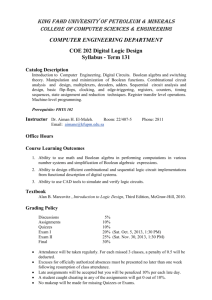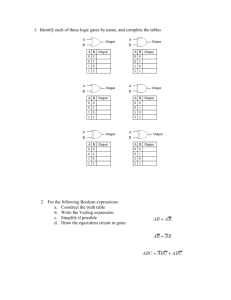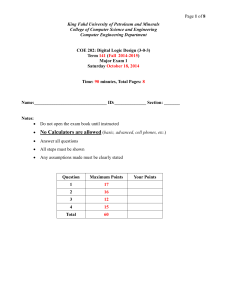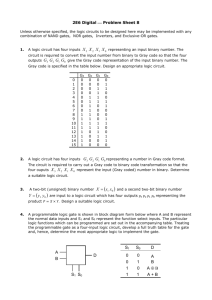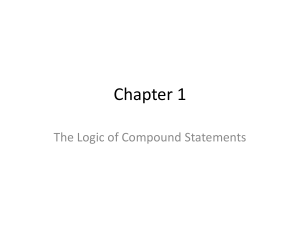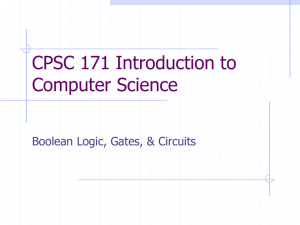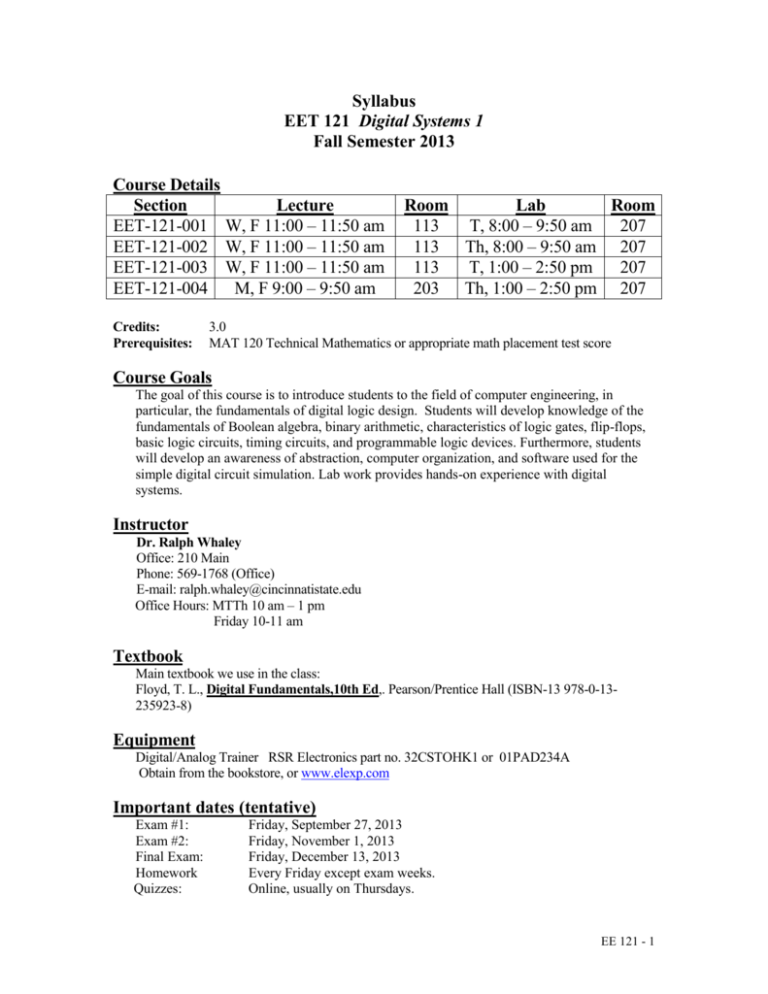
Syllabus
EET 121 Digital Systems 1
Fall Semester 2013
Course Details
Section
Lecture
EET-121-001 W, F 11:00 – 11:50 am
EET-121-002 W, F 11:00 – 11:50 am
EET-121-003 W, F 11:00 – 11:50 am
EET-121-004
M, F 9:00 – 9:50 am
Credits:
Prerequisites:
Room
Lab
Room
113
T, 8:00 – 9:50 am
207
113 Th, 8:00 – 9:50 am 207
113
T, 1:00 – 2:50 pm
207
203 Th, 1:00 – 2:50 pm 207
3.0
MAT 120 Technical Mathematics or appropriate math placement test score
Course Goals
The goal of this course is to introduce students to the field of computer engineering, in
particular, the fundamentals of digital logic design. Students will develop knowledge of the
fundamentals of Boolean algebra, binary arithmetic, characteristics of logic gates, flip-flops,
basic logic circuits, timing circuits, and programmable logic devices. Furthermore, students
will develop an awareness of abstraction, computer organization, and software used for the
simple digital circuit simulation. Lab work provides hands-on experience with digital
systems.
Instructor
Dr. Ralph Whaley
Office: 210 Main
Phone: 569-1768 (Office)
E-mail: ralph.whaley@cincinnatistate.edu
Office Hours: MTTh 10 am – 1 pm
Friday 10-11 am
Textbook
Main textbook we use in the class:
Floyd, T. L., Digital Fundamentals,10th Ed,. Pearson/Prentice Hall (ISBN-13 978-0-13235923-8)
Equipment
Digital/Analog Trainer RSR Electronics part no. 32CSTOHK1 or 01PAD234A
Obtain from the bookstore, or www.elexp.com
Important dates (tentative)
Exam #1:
Exam #2:
Final Exam:
Homework
Quizzes:
Friday, September 27, 2013
Friday, November 1, 2013
Friday, December 13, 2013
Every Friday except exam weeks.
Online, usually on Thursdays.
EE 121 - 1
Assignments
Quizzes and Exams
We will have three exams (two Midterms and one Final) in this course to give you the
opportunity to show that you have mastered the knowledge and skills addressed. Two
midterm exams have the same weight and cover roughly two halves of the course work, while
the final exam is based on all class works including the lab modules. Quizzes for this class
will be online and cover both lab and course material. Quizzes will be timed and due before
the beginning of the Friday class.
Homework Exercises
Exercises will be assigned weekly throughout the term to assist you in mastering the basic
course concepts. Homework will be due each Friday at the end of class. Unless you have a
prior agreement with the professor, any homework turned in after the due date will be
downgraded by 25% for the first 3 days (the following Wednesday usually). After that, it
will not be accepted. It is strongly encouraged that any student having difficulty with
homework assignments come to office hours or email the instructor with questions.
Labs and Lab Reports
Students are required to attain a digital/analog trainer by the 2nd lab of the course (2nd week
of classes). All students will be working independently during the lab session. Prior to each
session (except for the 1st meeting), lab materials will be posted on Blackboard. It is the
responsibility of the student to print the lab handout and review the material prior to coming
to lab. Most of the labs for this course also require exercises and/or calculations to be done
prior to the lab meeting and all students must come to the lab prepared, which is graded.
Students are also strongly encouraged to set up circuits on their digital trainers prior to the lab
session as well as perform necessary circuit simulations. Students are required to submit a
lab report for every lab performed which is due by the beginning of the next lab session. The
format of these reports will be discussed at the first lab session.
Grading
The percentage weight of various evaluation components used in this course is given below:
CLASS WORK (70%)
Homework (15%)
Online Quizzes (15%)
Midterms (20% each)
Final Examination (30%)
93-100
90-92
87-89
82-86
80-81
77-79
LAB WORK (30%)
Attendance/Timeliness/Preparedness (20%)
Lab Performance/Results (40%)
Lab Report (40%)
A
AB+
B
BC+
72-76
69-71
67-68
62-66
59-61
0-58
C
CD+
D
DF
The above grade levels are assured, however, the actual grading for this course depends on actual
performance of the class. In other words, an A could begin at 85, depending on the average
scores of the class on all material.
EE 121 - 2
Attendance
Due to the participatory nature of this course, attendance in class activities will be required.
Exceptions to this will be noted, however attendance for class will not be taken. If you will
need to miss class for some reason, you should contact Prof. Whaley in advance to determine the
consequences of missing class. If you need to miss a lab session for any reason, you must
contact Prof. Whaley in advance and make arrangements to make up the lab before the next lab
session, otherwise, you will receive no credit for the lab.
Academic Honesty
Instances of academic dishonesty could result in an "F" for the course and a referral to the
Cincinnati State judiciaries that may impose additional sanctions if warranted. Academic
dishonesty includes, but is not limited to, the following examples: permitting another student to
plagiarize or cheat from your work (Cheating implies dishonesty or deception in fulfilling
academic requirements. Plagiarism involves the presentation of some other person's work as if it
were the work of the presenter.), submitting an academic exercise (written work, printing,
sculpture, computer program) that has been prepared totally or in part by another, acquiring
improper knowledge of the contents of an exam, using unauthorized material during an exam,
submitting the same paper in two different courses without knowledge and consent of professors,
or submitting any forged documentation.
Collaboration
Students are encouraged to work together on homework assignments, however, submitting
work that is not one's own is considered academic dishonesty and also teaches you nothing.
If you are having any problems with any material in the class, please see Professor Whaley or
contact him by phone or email.
Classroom Privacy
While it is sometimes desirable for classroom practices to be observed for the purpose of
improvement of pedagogy, and such observation is sometimes required for annual faculty
evaluation and for tenure and/or promotion evaluation, faculty are entitled to classroom
privacy, academic freedom, and professional courtesy. Consequently, observation and
evaluation of any classroom by any observer or evaluator requires the prior notification and
mutual agreement of the class instructor and the observer or evaluator. Furthermore,
recording of classroom activities by any electronic means, by students, other faculty,
university administrators, or others, requires permission of the instructor. All students in a
class must be informed if permission has been given for a class to be recorded. Under no
circumstances may verbatim recording of copyrighted classroom lectures and materials by
electronic or any other means (including note taking) be conducted for 1) sale, whether or not
it is for educational benefit, or 2) for the educational benefit of those not enrolled in the class.
This does not apply to non-verbatim notes taken by students.
Disabilities Policy
Any student with a disability necessitating accommodations prescribed by the Americans
with Disabilities Act must meet with a Special Needs Counselor (Room Main 129) prior to
participating in classroom or laboratory activities. The Special Needs Counselor must
determine your accommodation requirements. They may be contacted at 569-1775.
EE 121 - 3
Specific Student Outcomes
The primary student outcomes desired for this course listed by topic are:
Information and data Representation
an ability to express numbers in decimal, binary, and hexadecimal
formats
an ability to represent characters with ASCII notation with and without
parity
an understanding of binary numbers
Computer Organization Introduction
an understanding of hierarchical design principles
an understanding of a generic microprocessor architecture
Computer Arithmetic
an ability to perform binary arithmetic
Boolean Algebra
an understanding of the basic operations and law of Boolean algebra
an ability to construct a truth table for a Boolean expression
an understanding of the minterms and maxterms of a Boolean algebraic
expression
Combinational Logic
an ability to implement a Boolean algebraic expression with digital logic
gates
an understanding of digital logic
Sequential Logic
an ability to construct a timing diagram for a digital system
an ability to implement basic synchronous sequential circuits with flipflops
an ability to derive the state table diagram from a sequential circuits
Digital Devices
an understanding of the operation of logic gates
an understanding of the operation of SR, T, JK, and D flip-flops
an understanding of the operation of counters and registers
an understanding of the operation of multiplexers, decoders and ROM
an understanding of the use of programmable logic devices
an understanding of the operation of timing circuits
Software Introduction
a knowledge of the basic circuit simulation software
121 Lab
an ability to experimentally validate a theoretical property
a knowledge of IC pin numbering
an ability to coordinate circuit simulation with hardware results
EE 121 - 4
Specific ABET Outcomes for this Course
The Electronics Engineering Technology (EET) curriculum is ABET (Accreditation
Board for Engineering and Technology) accredited and undergoes rigorous review every
six years to maintain this accreditation. From the ABET website:
ABET accreditation, which is voluntary and achieved through a peer review process,
provides assurance that a college or university program meets the quality standards
established by the profession for which the program prepares its students.
To that extent, this course contains elements critical to ABET accreditation in the
following defined areas:
a. an ability to apply the knowledge, techniques, skills, and modern tools of the discipline
to narrowly defined engineering technology activities.
b. an ability to apply a knowledge of mathematics, science, engineering, and technology
to engineering technology problems that require limited application of principles but
extensive practical knowledge.
c. an ability to conduct standard tests and measurements, and to conduct, analyze, and
interpret experiments.
e. an ability to identify, analyze, and solve narrowly defined engineering technology
problems.
f. an ability to apply written, oral, and graphical communication in both technical and
non-technical environments; and an ability to identify and use appropriate technical
literature.
i. a commitment to quality, timeliness, and continuous improvement.
EE 121 - 5
Tentative Schedule
Week of
Text
Chapter 1,3
Lab
Introduction to Digital
Trainer and MultiSim
Chapter 3
Basic gates
9/2
Course Material
Digital Concepts,
Binary numbers, Basic
Gates
Symbols, Boolean
Equations, Truth Tables
Eqs to Truth table, SOP
to Truth tables
Chapter 3
9/9
Circuit from rough
schematic
Boolean simplification,
DeMorgan's Theorem
Exam 1
Chapter 4
Circuit form boolean
equation
Circuit from written
instruction (panic light)
Karnough Maps I
Chapter 4
Circuit building lab test
Karnough Maps II
Chapter 4
Binary, Hex, BCD,
Adders and Math
functions
MUX/DMUX,
Decodes/Encoders
Chapter 2
PLD circuit operation
and programming
(Chapter 11)
Circuit from written
instructions (burgler
alarm)
Circuit from written
instructions (pH mixing
tank)
Circuit from written
instructions (Flow
meter readout)
8/26
9/16
9/23
9/30
10/7
10/14
10/21
Chapter 6
Exam 2
10/28
11/4
11/11
SR, D latches
Edge triggering
SR, D, JK Flip Flops
Asynchronous Counters
555 as One-shot
Chapter 7
Gated D Latch and D
Flip Flop
Chapter 7,8
Flip Flop frequency
divider
11/18
555 as oscillator
RAM/ROM
Chapter 7,10
555 One-shot &
Oscillator
12/2
RAM/ROM
programming
Chapter 10
ASCII Counter (Letters
A-Z) / Ch. 8
12/9
Storage Basics
Final Exam
Chapter 10
Manually load memory
with ASCII
EE 121 - 6


